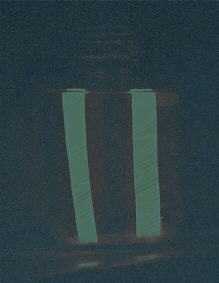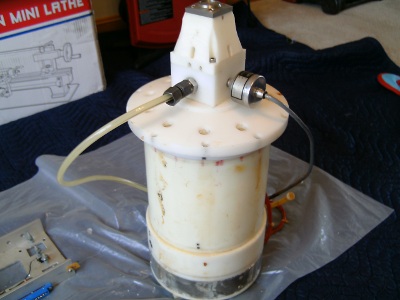The secret of Stan Meyer's "car on water" even he himself did not know

By Arend Lammertink, MScEE.
What follows is what I believe to be the true story about Stan Meyer's dune buggy, which has been shown to run on water on a TV station in Ohio.
http://www.youtube.com/watch?v=GFIlXaABU54
Somewhere around 1980-1985 the car ran on water, but then it stopped working.
Why?
What happened?
He happened to have used electropolished stainless steel.
But he did not know that.
Nobody did.
And nobody found out.
Until 2013.
Please share this information with your friends!
Blog, Facebook, Twitter, whatever.
The discovery of a secret
My investigation of this technology began at the energetic forum, where I joined in 2008. In December 2009, I noted that the similarities between John Bedini's "cold boiling batteries" and Stan Meyer's technology were striking:
Aaron Murakami commented:
Based on this, we can conclude that there is at least one known way to produce hydrogen and oxygen gas without any current being fed into the system and without any resonance whatsoever taking place.
Then, I did some experiments with a home-made electrolytic capacitor, using the recipe of Nyle Steiner. An interesting clue brought forth by Steiner is that old school electrolytic rectifiers, very similar to home made electrolytic capacitors, produce a visible glow during operation. Such a glow has also been reported by some of the more successful water fuel cell replicators.

The conclusion so far is that Meyers fuel cell must have been some kind of electrolytic capacitor made out of stainless steel instead of aluminum. Characteristic of electrolytic capacitors is that these are made by growing a very thin layer of a dielectric material, a material that can be polarized, on one of the metal capacitor plates. This is what gives an electrolytic capacitor its capacity. And as we saw, these kind of things show interesting behavior when they are charged with high voltage spikes, as both Bedini and Meyer did.
As I already suspected, polarized dielectrics can indeed provide excess energy, without breaking the law of conservation of energy. This follows from the excellent theoretical research of the German Professor Claus Turtur, who also proved his thesis experimentally by showing that an electric field can do work without drawing any current from the power supply:
http://www.youtube.com/watch?v=IiC2IGLl90Q
In this video, I explain the theory we have covered so far, which I also published on the open source energy forum in detail:
http://www.youtube.com/watch?v=tZf0yhe4B80
Now the question becomes: how can we create a suitable dielectric layer on stainless steel, such that we can make an electrolytic capacitor with stainless steel instead of aluminum? Since in aluminum based electrolytic capacitors the dielectric which makes the capacitor works is an oxide of aluminum which is grown electrochemically, we first need to find out which oxide could be grown on stainless which has the desired properties. That turned out to be chromium(III) oxide, Cr2O3, which has very similar dielectric properties as aluminum oxide. And then it turned out that it is exactly the right oxide which is being grown on stainless steel in a process called electropolishing, which has been used in the industry in a/o the food industry and for medical applications for years.
In other words: all that is needed to turn a water fuell cell along Stan's design into an electrolytic capacitor is to use electropolished stainless. A tiny detail, which turned out to have had major consequences. With electropolished stainless, you get a device capable of providing excess energy. Without it, you get, well, a big problem.
A working car that stopped working
Very little footage is available wherein the dune buggy is actually demonstrated to run. The best known footage is the news report, which aired in 1985. It is part of a video known as "Backyard Buggy Demonstration, long version" :
http://www.youtube.com/watch?v=m0qQ78LBNCE#
And that's about it. As far as I have been able to find, about 9 minutes of footage have survived wherein the dune buggy is actually shown being driven. While we cannot place exact dates on this footage, it appears that all of this footage has been taken in the period around 1980-1985, give or take a few years.
After that period, suddenly, no more footage of the car actually being driven is to be found. One of the most notable examples thereof is this documentary, aired by the BBC in 1994:
http://www.youtube.com/watch?v=vE6AkSE2JCk
In this video, the buggy is shown being driven, but that is old footage from the 1985 WTVN newscast. That raises the question: why did Stan not simply restore his old working system for this important occasion? Why is there footage from the early 80's, but is none to be found from the 90's?
The logical conclusion is that the car stopped working. But why? And why couldn't he fix it?
Did the injector system actually ever work in the car, or any engine for that matter?
If it did, why can we find videos of Meyer explaining and showing the car, but not a single one wherein the car is actually being driven? Why wouldn't he drive the car, unless it was uncapable of doing so?
Given the basic conclusion from my theory, which is that the system could not have worked unless he would have used electropolished stainless, it is interesting to know what kind of stainless he might have used. A private email sent to me said this:
When we add all this together, I think we can reasonably conclude that Stan got his car running ONLY during the (early) 80's and that it is likely that he used scrap components. So, it is entirely possible and even likely that he just happened to get his hands on a set of scrap electropolished stainless tubes, whatever the source of these might have been. And since it is very likely that the dielectric "passivation" layer on the stainless will slowly but surely wear out when being plagued with high voltages, we can reasonably conclude that the performance of the system slowly degraded until eventually the car stopped working altogether. He may have had additional electropolished tubes from the same source with which he might have kept things going for a certain amount of time, but at some point, it was all over. And whatever he tried, that single special batch of tubes were the only tubes that worked.
So, what would you have done? You would have gotten your steel tested. And that is exactly what Stan did. On page 46 of a WFC report we find the results of a chemical analysis of steel samples provided by Stan, dated December 22, 1982.
The results of these analysis were that the composition of the steel was just ordinary 304 stainless steel. Exactly what you would expect with electropolished stainless, because the only difference between ordinary steel and electropolished steel is the thickness of the passivation layer which normally protects the stainless from rusting, BUT is also a dielectric, a key ingredient for making an electrolytic capacitor.
One can only imagine what Stan must have gone trough. He HAD a working car on water. He KNEW it was possible. But the car stopped working and he never found out why. He went everywhere for answers, even to NASA, and ran into a brick wall wherever he went.
Yet, he never gave up. All he wanted is to make this a better world for all of us.
And we OWE it to him and our children to finish this. Now that we understand HOW it works, we have everything we need to do so. We can't change the past, but we can change the future. And that's what we are going to do, working "open source" together. NO ONE can stop this anymore, we're in for a revolution. One one simply cannot kill an idea.
May Stan rest in peace and may the fruits of the unprecedented accomplishments of this great inventor finally lead to peace and prosperity on this planet.
Update Sept 14, 2013: The injectors did work up to a certain degree
Amsy posted the following comment:
http://www.youtube.com/watch?v=OXctY1K4wko (13:20)
I did not have a chance to watch this yet, but it is good news that the injectors actually worked up to a certain degree. There is a difference between running an engine unloaded and actually being able to drive around with it, though. And the injector system is a lot harder to implement and replicate, because they require complicated machining to make. And they appear to work on HHO or Brown's gas instead of hydrogen gas, given that the surface areas of the active parts of the injector are much smaller than in the WFC, which makes it very unlikely that these could actually work along the principles explained in this article.
The properties of Brown's gas are very interesting and do make it possible to run engines on water. This phenomenon has been researched by a/o Chris Eckman, who relates this phenomenon to crystal structures:
This connects very nicely to the work of Prof. Gerald Pollack, who discovered that water can indeed exist in what he calls a "fourth phase", somewhat in between liquid and ice, characterized by a crystal structure. This is being discussed here. The work of these and other researchers is very interesting, which may even include the possibility of cleaning up nuclear waste. I have been in contact with both Gerald and Chris and pointed them to each others work, as well as to my own research. All in all, very promising progress is being made at that front, because when the Pollack's phenomenon is indeed one and the same as what is mostly known as Brown's gas, we will gain a lot of understanding of for example how lightning works. Another subject is that this phenomenon appears to play an important role in biology. More details in the discussion mentioned.
However, one of the difficulties with HHO based systems is that one needs water fog besides the HHO gas, AFAIK. And, as far as I can tell at this moment, one can achieve a COP (coefficient of performance) of no more than about 10-20 with HHO based systems. A friend of mine built one an he says he needs about 6 KW of power to run an engine delivering 50 KW of output power and about 30 kW of heat. This system indeed needs water fog besides the Brown's gas. Maybe others have been more successful, but Stan's original design needed much less input power than what I have seen these kinds of systems needing.
So, to me the story of the original design, which does appear to have been far superior to any HHO based system I have seen, still stands. With his first prototype, Stan was able to run his dune buggy from the standard battery in the car, AFAIK, and that means you would be talking about a COP of at least 500. And since he could not show a running buggy to the BBC, the case that the original system indeed stopped working also still stands.
And since the HHO phenomenon is only in its beginning stages of understanding, while the WFC system is now fully understood as is hydrogen as a fuel, there still is every reason to make sure we get this original WFC design working again.
Update Sept 18, 2013: Another video of the first prototype being driven surfaced
Irondmax was kind enough to point me to another video which shows the buggy being driven:
source: http://www.youtube.com/watch?v=eKbXn9Zy_LU
Note: this video is no longer available on YouTube. On-site copy here.
I made a still shot from what I believe to be the Water Fuel Cell in the running car:

In this image, you can clearly see that this WFC has been made with off the shelf tubes and mirrors the design of his earlier test cell.
The WFC's which have survived and where in Stan's estate, look quite different:

So, clearly, the WFC in the actually running car was not like the later designs, of which the drawings have survived. And because Stan had steel samples with two diameters tested in 1982, for which there would have been no reason at all if he would have used new pipes since then the composition would have been known, it is very likely that the first prototype has indeed been built with scrap components.
Final words
This article may be freely copied, distributed, translated, etc. A link to this page and/or mentioning of www.tuks.nl as source is appreciated, because the page may be updated further in the future.
Contact info, etc. here.
And you can follow me on Twitter or go to my facebook page.
